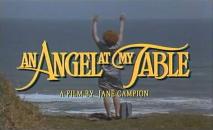AustLit
 3516009878921169727.jpg
3516009878921169727.jpg
Latest Issues
AbstractHistoryArchive Description
Based on the autobiographies of New Zealand author Janet Frame.
Publication Details of Only Known VersionEarliest 2 Known Versions of
Works about this Work
-
Letter Writing and Space for Women’s Self-expression in Janet Frame’s Owls Do Cry and Jane Campion’s An Angel at My Table
2021
single work
essay
— Appears in: Life Writing , vol. 18 no. 1 2021; (p. 79-94)'This essay engages with life writing in Janet Frame’s 1957 novel, Owls Do Cry and Jane Campion’s 1990 film biopic of Frame’s autobiographies, An Angel At My Table. It aims to consider the physical and socio-political constraints on women’s writing, and how these may be deconstructed through non-conventional forms of intellectual exploration. Communication between women is explored in the formats used in both Frame’s novel and Campion’s film. With a primary focus on letter writing, this essay also considers diary entries, published literary work, the film text, and silence as areas of interest. This essay employs the form of letter writing in attempt to explore the medium used by Frame and the characters in Owls Do Cry as an alternative form of intellectual scholarly practice. In doing so, it aims to consider Frame’s literary legacy as a paradigm for academic study, in which women’s varied creative practices can be considered for academic exploration. The letter form also signifies an attempt to recontextualise the letter form, in order to compare the constraints on women’s writing in 1940s and 1950s New Zealand with twenty-first-century concerns about gender equality in academia and creative writing.' (Introduction)
-
An Angel at My Table (Jane Campion, 1990)
2017
single work
column
— Appears in: Senses of Cinema , September vol. 84 no. 2017; -
An Angel at My Table (1990) : Janet Frame, Jane Campion, and Authorial Control in the Auto/biopic.
2016
single work
criticism
— Appears in: Journal of New Zealand Literature , vol. 34 no. 1 2016; (p. 103-122, 5)'What happens when an autobiographical project is taken up by film? How can visual media extend, distort, and reshape the image of the author? Janet Frame was a writer particularly concerned with modes of authorial representation, both visual and writerly. Her posthumous novel In the Memorial Room (2013) describes the writer Harry Gill's tenure of the Watercress-Armstrong Fellowship in Menton, France. At the reception celebrating his arrival in Menton, he is greeted by Connie Watercress, benefactor of the fellowship, her husband Max and their son Michael, a 'handsome richly bearded young man, the perfect stereotype of the 'young writer''. At this reception, the mayor of Menton approaches the foursome to take a photograph with the new Watercress-Armstrong Fellow - and mistakenly extends his hand to Michael. Though the mistake is immediately recognised, and the mayor sheepishly turns to Harry, it is too late - the photographers have already taken their photo, memorialising the event.. (Introduction)
-
An Angel at My Table
2011
single work
criticism
— Appears in: Making Film and Television Histories : Australia and New Zealand 2011; (p. 189-193)
-
An Angel at My Table
2011
single work
criticism
— Appears in: Making Film and Television Histories : Australia and New Zealand 2011; (p. 189-193) -
An Angel at My Table (1990) : Janet Frame, Jane Campion, and Authorial Control in the Auto/biopic.
2016
single work
criticism
— Appears in: Journal of New Zealand Literature , vol. 34 no. 1 2016; (p. 103-122, 5)'What happens when an autobiographical project is taken up by film? How can visual media extend, distort, and reshape the image of the author? Janet Frame was a writer particularly concerned with modes of authorial representation, both visual and writerly. Her posthumous novel In the Memorial Room (2013) describes the writer Harry Gill's tenure of the Watercress-Armstrong Fellowship in Menton, France. At the reception celebrating his arrival in Menton, he is greeted by Connie Watercress, benefactor of the fellowship, her husband Max and their son Michael, a 'handsome richly bearded young man, the perfect stereotype of the 'young writer''. At this reception, the mayor of Menton approaches the foursome to take a photograph with the new Watercress-Armstrong Fellow - and mistakenly extends his hand to Michael. Though the mistake is immediately recognised, and the mayor sheepishly turns to Harry, it is too late - the photographers have already taken their photo, memorialising the event.. (Introduction)
-
An Angel at My Table (Jane Campion, 1990)
2017
single work
column
— Appears in: Senses of Cinema , September vol. 84 no. 2017; -
Letter Writing and Space for Women’s Self-expression in Janet Frame’s Owls Do Cry and Jane Campion’s An Angel at My Table
2021
single work
essay
— Appears in: Life Writing , vol. 18 no. 1 2021; (p. 79-94)'This essay engages with life writing in Janet Frame’s 1957 novel, Owls Do Cry and Jane Campion’s 1990 film biopic of Frame’s autobiographies, An Angel At My Table. It aims to consider the physical and socio-political constraints on women’s writing, and how these may be deconstructed through non-conventional forms of intellectual exploration. Communication between women is explored in the formats used in both Frame’s novel and Campion’s film. With a primary focus on letter writing, this essay also considers diary entries, published literary work, the film text, and silence as areas of interest. This essay employs the form of letter writing in attempt to explore the medium used by Frame and the characters in Owls Do Cry as an alternative form of intellectual scholarly practice. In doing so, it aims to consider Frame’s literary legacy as a paradigm for academic study, in which women’s varied creative practices can be considered for academic exploration. The letter form also signifies an attempt to recontextualise the letter form, in order to compare the constraints on women’s writing in 1940s and 1950s New Zealand with twenty-first-century concerns about gender equality in academia and creative writing.' (Introduction)
-
cNew Zealand,cPacific Region,
- 1920-1940



